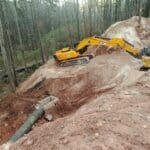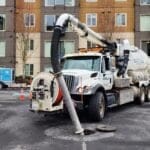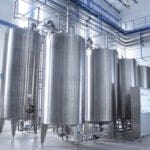EPA Stormwater Management: Understanding Stormwater Inspection, Reporting Standards and Requirements
by Jason Abert, Vice President of Service Delivery
Did you know that for your business to be compliant with Environmental Protection Agency (EPA) stormwater management guidelines, it must follow a standard set of laws and regulations outlined in the Clean Water Act (CWA)? The CWA is responsible for managing discharge of pollutants that may end up in the Waters of the U.S. (WOTUS), as well as regulating quality standards for surface water [1]. CWA guidelines help to manage any municipal, agricultural, and industrial waste that could potentially be discharged into the WOTUS as a pollutant (meaning any sediment, trash, biological or chemical waste, solid waste, radioactive material, discarded equipment, sand, rocks, etc.) [1]. These requirements are put in place is to make sure that mismanaged stormwater, that could potentially be full of pollutants, does not get washed into the WOTUS and ultimately end up in our drinking water supply and environment for years to come. For your business to be compliant with stormwater regulations, it may need to obtain a National Pollution Discharge Elimination Permit, or NPDES. Consulting with a stormwater professional to ensure that your stormwater system is compliant with EPA guidelines and NPDES permits can be vital for you and your operations.
NPDES permits are mandatory for every municipality or facility to ensure that uncontrolled pollutants do not get discharged into the WOTUS by any persons or businesses. To comply with the stormwater management program outlined by the NPDES, there are six control measures:
- Public Education and Outreach
- Public Participation/Involvement
- Illicit Discharge Detection and Elimination
- Construction Site Runoff Control
- Post-Construction Runoff Control
- Pollution Prevention/Good Housekeeping
Addressing each area will ensure that your stormwater management program is compliant in whole. NPDES permits protect water by controlling the pollutant level in a discharge or by implementing stormwater control measures that capture pollutants prior to entering into the waterways [1]. Additionally, routine inspection and maintenance visits are required by a professional over the life of the system in order to meet quantity and quality objectives. Quantity is managed by the capture and slow release of the discharge coming from your system, and quality is managed by the capture and treatment of pollutants prior to discharging to WOTUS [2]. Many municipalities are required to apply for a NPDES permit to operate stormwater systems, and from there must designate a stormwater management plan to reduce the amount of contaminated discharge entering the waterways.

It is required to have a stormwater pollution prevention plan (SWPPP) set up for your facility before construction begins to ensure that the site is compliant with EPA stormwater management guidelines. An SWPPP includes any site inspection, erosion and sediment control best management practices (BMPs), good housekeeping BMPs, post-construction BMPs, or SCMs, and schedules for good housekeeping and inspection that will need to be implemented and maintained for a stormwater system to control post-construction runoff [2]. Stormwater professionals are trained to handle every aspect of your SWPPP and function to ensure compliance with EPA post-construction guidelines.
Post-construction runoff control applies to any site that is either developed or undeveloped and is equal to or larger than an acre of land. Stormwater Control Measures (SCMs) are designed and constructed to control post-construction runoff long-term. SCMs use both engineered and biological processes to remove excess pollutants and control post-construction runoff, and without proper maintenance on these systems, they cannot function the way they were designed. Oftentimes, if these sites and systems are left unmaintained, they will need significant repairs; this could be due to the buildup of sediment and heavy vegetation, leading to a system blockage, structural failure, and/or an inability for water to infiltrate into the water table.
In the long run, businesses (including yours) will almost always incur more costs on unplanned repairs and fines than on routine preventative maintenance. For the EPA to monitor the effectiveness of NPDES permits, facilities are required to sample its discharges and notify the EPA and the state regulatory agency of the results; if either of these parties finds that your facility is in violation of your NPDES permit, your business can be hit with heavy penalties such as: monetary penalties, civil and criminal action and even jail time [1]. Municipalities are tasked with recording all post-construction maintenance and monitoring activities of property owners, and with reporting on the adherence to the regulations. Many municipalities also have stormwater inspectors in place to verify that stormwater is being managed according to the law both on the construction and post-construction side. Maintenance plans, often called Operations and Maintenance (O&M) Agreements, are prepared to help you with maintenance scheduling, inspection violations, repair notices, and a general background on stormwater assets so that you can avoid non-compliance. When it comes to EPA requirements, having a maintenance plan in place will be one of the most important parts of your stormwater system plan.
When underground and aboveground SCMs are designed, it is with the expectation that routine maintenance will be performed throughout the life of the system to ensure functionality [1]. We want to make sure that you are compliant with every part of EPA regulation and that your business or operation avoids hefty fines and penalties for non-compliance (https://aqualisco.com/common-stormwater-violations-and-their-consequences) Our employees are trained and qualified to know every part of the process, so that you don’t have to. At AQUALIS we have solutions https://aqualisco.com/solutions to your stormwater problems, so reach out to our professionals for any questions your business might have!
 Kenosha, Wis. Highway KR Regenerative Stormwater ConveyanceThe Root-Pike Watershed Initiative Network Kenosha County, and others worked with AQUALIS to design and implement an innovative solution for stormwater control along Highway KR.
Kenosha, Wis. Highway KR Regenerative Stormwater ConveyanceThe Root-Pike Watershed Initiative Network Kenosha County, and others worked with AQUALIS to design and implement an innovative solution for stormwater control along Highway KR. Durham, N.C. Sinkhole Leads to Stormwater System RehabilitationThe tenant on this property noticed a depression that opened to the ground below and notified the property owners.
Durham, N.C. Sinkhole Leads to Stormwater System RehabilitationThe tenant on this property noticed a depression that opened to the ground below and notified the property owners.



